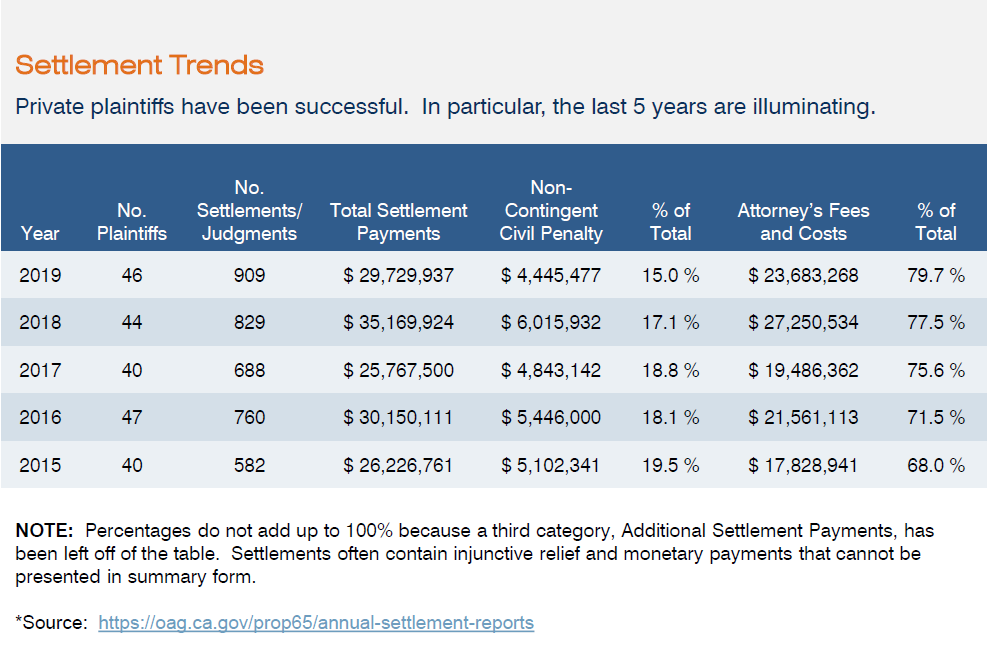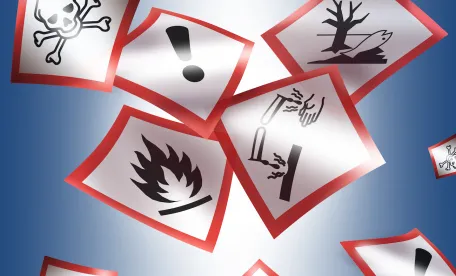According to the Center for Accountability in Science, since 2010, businesses have spent over $182 million to settle Prop 65 lawsuits. What most companies do not realize is that 75% of settling businesses were headquartered outside of California.1 Prop 65 impacts all companies whose product or the use of its product ends up in California. Impacted businesses include manufacturers, distributors, packagers, importers, suppliers and other components in the supply chain.
To add to the concern and uncertainty, California regularly adds chemicals to their growing Prop 65 list. Moreover, if you have a California facility, there are additional aspects of Prop 65 of which you need to be aware. Businesses that sell into California and are unaware of the Prop 65 requirements face significant fines and penalties including the risk of product recalls or removals as well as potential product reformulation.
Background
In 1986, California voters approved an initiative to address growing concerns about exposure to toxic chemicals. That initiative became the Safe Drinking Water and Toxic Enforcement Act of 1986, California Health and Safety Code §25249.6 et seq. and is better known by its original name, Proposition 65 (Prop 65). The intent of Prop 65 was to assist Californians in making informed decisions about protecting themselves from chemicals known to cause cancer, birth defects, or other reproductive harm. As such, Prop 65 does not ban the sale of any products into the State of California; rather, it requires “clear and reasonable” warnings in order for consumers to be aware of potential exposures due to what is contained in the items they purchase.
General Requirements
The Prop 65 program is administered by the Office of Environmental Health Hazard Assessment (OEHHA), which is part of the California Environmental Protection Agency. Prop 65 applies to all products sold in California from stores, through the mail, and on the internet. No company doing business in California is permitted to knowingly and intentionally expose any person to a chemical, in any amount, that is on the list of chemicals, without first providing a “clear and reasonable” warning before exposing consumers and the general public to chemicals that are known to the State of California to cause cancer, birth defects, or other reproductive harm. The state maintains a list of approximately 1,000 (and growing) chemicals that are subject to the provisions of Prop 65.
Any business that exposes individuals to a listed chemical must provide a “clear and reasonable” warning that reaches the consumer prior to exposure. Consumer product exposure warnings must be prominently displayed on a label and must be displayed with conspicuousness when compared to other words, statements, designs, or devices on the label. Consumer product exposure warnings must be prominently displayed such that the warning is likely to be seen, read, and understood by an ordinary individual under customary conditions of purchase or use. It is the responsibility of persons doing business in the State of California to ensure that their products are properly identified in accordance with Prop 65.
Warning Labels
As of August 2018, where a warning label is required, there are specific regulatory requirements for what is contained in the warning label: a warning symbol  , the word “WARNING” in all capital letters and in bold print, an explicit statement of the specific chemical causing exposure, and an explicit statement as to whether the chemical causes cancer or birth defects or other reproductive harm. The entire warning must be in a type size no smaller than the largest type size used for other consumer information on the product. In no case shall the warning appear in a type size smaller than 6-point type.
, the word “WARNING” in all capital letters and in bold print, an explicit statement of the specific chemical causing exposure, and an explicit statement as to whether the chemical causes cancer or birth defects or other reproductive harm. The entire warning must be in a type size no smaller than the largest type size used for other consumer information on the product. In no case shall the warning appear in a type size smaller than 6-point type.
Furthermore, additional amendments to Prop 65 become effective April 1, 2020. These amendments clarify the regulatory provision implementing the statutory direction to place the primary obligation for providing a Prop 65 warning on the product manufacturer, thus minimizing impact of the warning requirements on a retail seller. Businesses will also have more clarity concerning the level of specificity required in notices to authorized agents for retail sellers, and the express incorporation of existing law on imputation of knowledge to the business.
Exemptions
Prop 65 provides for several limited exemptions. It does not apply to federal, state, and local government agencies, nor does it apply to businesses with nine or fewer employees. Furthermore, a warning is not required if a business can demonstrate that any exposure occurs at a level that poses “no significant risk” as it relates to carcinogens or that the level of exposure is below the “no observable effect level” as it relates to reproductive toxicants.
Safe Harbor Provisions
In simplest terms, a “Safe Harbor Level” is a level of exposure to a listed chemical that does not require a warning. If a product contains or emits a chemical on the Prop 65 List, and if the exposure is either (a) below the “no significant risk level” (NSRL) for chemicals causing cancer or (b) below the “maximum allowable dose level” (MADL) for chemicals causing reproductive toxicity, then no warning is required.
By law, a warning must be given for listed chemicals unless exposure is low enough to be “safe,” meaning that it poses no significant risk of cancer or the risk is significantly below levels observed to cause birth defects or other reproductive harm. Together, NSRLs and MADLs are known as “Safe Harbor Levels.”
California has developed Safe Harbor Levels for approximately 300 of the 1,000 plus chemicals on the Prop 65 List. If the state has not set a Safe Harbor Level, or if the business wants to know how an established Safe Harbor Level impacts their product, the business may consider conducting a risk assessment to determine the level of allowable exposure. If a Prop 65 chemical is in the product, but the level of exposure is below the Safe Harbor Level, then no warning label is required.
Where a responsible party can show that exposure poses no significant risk, assuming lifetime exposure at the level in question for substances known to the state to cause cancer, birth defects or reproductive harm, and that the exposure will have no observable effect, it is exempt from the warning requirement. In any action brought pursuant to Prop 65, the burden of showing that an exposure meets the exposure criteria is on the defendant.
Enforcement
Primary jurisdiction for the enforcement of Prop 65 is vested in the Attorney General and certain designated city and district attorneys. However, Prop 65 also allows that any individual acting in the public interest may enforce Prop 65 by filing a lawsuit against a business alleged to be in violation of the law. For a private citizen to bring an action, the plaintiff must first give written notice to the alleged violator and the designated public prosecutor. Plaintiffs must also execute a “certificate of merit” stating that they have consulted with experts and have a reasonable belief that their claims have merit. If the designated public prosecutor fails to commence a civil action within 60 days, a private citizen plaintiff may then commence an action.
A plaintiff may bring a Prop 65 lawsuit if she can demonstrate exposure to any amount of a listed chemical in a product. Once a plaintiff shows that there is potential exposure to a listed chemical in a product with no warning, the burden falls on the defendant to prove that the amount of chemical is below the Safe Harbor Level. This is established primarily by expert analysis, in which experts run exposure assessments to see how much exposure to a chemical occurs through typical use of the product, with measurements of exposure targeting dermal, ingestion or inhalation of the chemical.
Violations of Prop 65 are subject to stiff enforcement, resulting in penalties of up to $2,500 per day for each violation. In determining how much to assess for each violation, the following factors are considered: the nature and extent of the violation; the number of, and severity of, the violations; the economic effect of the penalty on the violator; whether the violator took good faith measures to comply with the regulations and the time these measures were taken; the willfulness of the violator’s misconduct; and the deterrent effect that the imposition of the penalty would have on both the violator and the regulated community as a whole. Private citizen plaintiffs can receive 25% of any civil penalties collected (in addition to attorneys’ fees), providing a large incentive for them to maximize the number of violations alleged and the amount of penalties assessed per violation.
Settlement
Settlement Components
The overall cost of settlement of a Prop 65 claim will include various components such as a civil penalty, attorney’s fees, and costs to comply with the settlement. As far as the civil penalty and attorney’s fee components are concerned, the California Office of the Attorney General keeps comprehensive database records of all of the Prop 65 notices issued and associated settlements. With regard to costs to comply with the settlement, there is a wide range in the costs due to the fact that compliance requires affirmative actions on behalf of the settlor. These affirmative actions include, but are not limited to, adding warning labels to products that are still for sale in the State of California, a reformulation of the offending product(s), removal of products from shelves of stores in the State of California, or a recall of products that have already been sold to customers in the State of California.
Settlements under Prop 65 can be private settlements or settlements entered into “in the public interest.” A private settlement is entered into with an individual company and will only settle claims with that individual company, not with the population in general. A settlement entered into “in the public interest” can be broader; however, these releases generally involve the courts or the Attorney General.
Settlement Trends
Private plaintiffs have been successful. In particular, the last 5 years are illuminating.

NOTE: Percentages do not add up to 100% because a third category, Additional Settlement Payments, has been left off of the table. Settlements often contain injunctive relief and monetary payments that cannot be presented in summary form.
*Source: https://oag.ca.gov/prop65/annual-settlement-reports
How Can Companies Best Protect Themselves from the Long Reach of Prop 65?
Know Your Product(s’) Contents and Determine Which Product(s) Need a Warning
In order to assure compliance with Prop 65, it is imperative for a company to develop and continuously follow a Prop 65 compliance management program. These types of programs have two major components: (1) keeping up with current product lines to ensure they continue to be in compliance with Prop 65 regulations and (2) establishing a strategy for new product lines as they are developed to ensure Prop 65 compliance from the start.
In order to ensure that the program is followed, many companies designate a “Prop 65 Compliance Monitor” to ensure that one specific person is taking responsibility for periodic reviews to confirm the essential practices and protocols are being followed. The Compliance Monitor should also check in with counsel periodically to ensure that there are no changes to the Prop 65 regulations that have been proposed or implemented which might impact the company’s Prop 65 compliance program.
Continuing Prop 65 Compliance for Existing Product Lines – Best Practices
A best management practice for approaching Prop 65 compliance is through a strategic and comprehensive business strategy to preemptively address potential Prop 65 issues. Following are recommended Best Practices:
-
Ensure that all catalogs and websites are kept up to date and contain proper warnings.
-
Keep clear records/files that you can easily find when necessary. This includes tracking Vendor/Supplier products in an organized fashion with tracking documentation containing:
-
Product/component description;
-
Vendor/Supplier name;
-
Whether product/component is Prop 65 compliant;
-
Whether product/component requires a warning label (and whether the warning label, if required, meets applicable regulations); and
-
Any corresponding documents supporting Prop 65 compliance (including applicable SDS sheets, compliance certification forms, and Annual Certification forms); and.
-
-
Monitor all Vendors/Suppliers to ensure that their products remain free of Prop 65 chemicals or that the components have the requisite warning labels. Create an Annual Compliance Certification wherein Vendors/Suppliers certify the chemical composition of products and provide indemnification for your company from losses arising out of a Prop 65 violation impacting your company.
-
If Vendors/Suppliers are unable to confirm that Prop 65 chemicals are absent from their products or refuse to certify that their products are Prop 65 compliant, consider performing independent laboratory testing.
Prop 65 Compliance for New Product Lines – Best Practices
-
Each new product must be evaluated to ensure compliance with Prop 65. This can be accomplished by requesting and reviewing documents, including but not limited to, laboratory reports pertaining to the new product/product line.
-
Once a prospective Vendor/Supplier provides a signed Compliance Certification form and related documentation, it must first be determined whether Prop 65 labeling is necessary — and if Prop 65 labeling is necessary, the company must determine whether the labeling meets applicable regulatory requirements.
-
At this point in the Prop 65 compliance management process, it may be necessary to include an in-house or external compliance expert to make the final compliance recommendations for sales and labeling. Only after all of these steps have been implemented should the new products be ordered or new product line established.
-
Once Prop 65 compliance for new product lines has been established, it is important to ensure that compliance continues by following the strategy for continuing Prop 65 compliance for existing product lines established above.
Conclusion
Companies doing business in California need to be aware of the long reach of Prop 65. By understanding the chemical components of their products and their vendors’ products and staying current on the Prop 65 changes, companies can take the investigative and warning labeling actions necessary to best protect themselves from Prop 65 violations.
1 Center for Accountability in Science, 2018, Prop 65 State Impact Report




 />i
/>i
